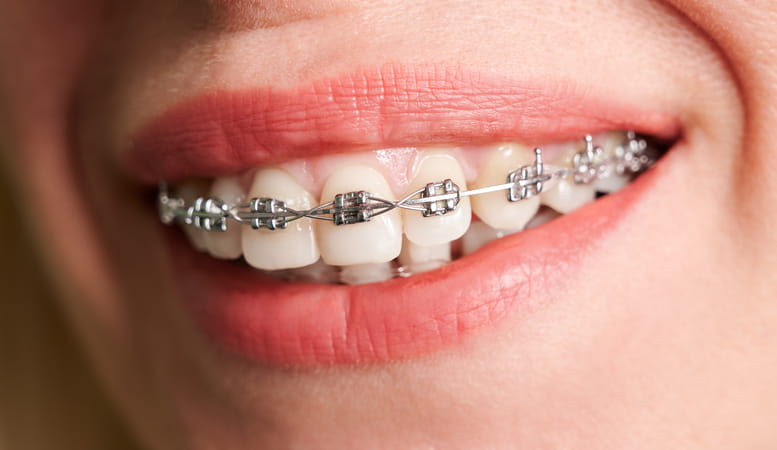How Do Self-Ligating Braces Work?
Like traditional metal or ceramic braces, self-ligating braces use brackets and an archwire to apply pressure to the teeth. This pressure gradually pushes and pulls the teeth into alignment over time. The difference is that self-ligating braces secure the archwire differently.
Self-ligating braces use brackets with a “gate,” allowing the archwire to pass through it. It then locks to hold the archwire against the tooth, continually applying pressure and achieving fast results. Many patients and orthodontists prefer this treatment method over elastic bands on each bracket and tooth.
Types of Self-Ligating Braces
Different types of self-ligating brackets may work better for your individual needs. Ask your orthodontist about these options.
Active Braces
Self-ligating braces with active brackets have a sliding mechanism with a spring clip that is able to close, pressing the archwire against the teeth. Because the bracket clip applies an active force on the wire, they are referred to as active braces.
Passive Braces
While passive brackets on self-ligating braces also have a sliding mechanism, they do not clamp down on the archwire like active brackets do. Instead, they simply hold the archwire down.
Other Types
Additionally, your dentist may offer metal self-ligating braces or ceramic self-ligating braces, giving you more choices. Ceramic braces are tooth-colored to blend in with your natural smile. Metal brackets are less discreet but very effective. Our orthodontists can explain more about the colors of self-ligating braces during a consultation.
How Much Faster Are Self-Ligating Braces?
Some studies have shown that self-ligating braces can produce faster results than traditional metal or ceramic braces. In the first four months of treatment, orthodontic patients with self-ligating braces showed significantly more improvement in the alignment of the upper teeth than those with conventional braces that use elastic bands.
If you’re looking for faster results with your orthodontic treatment, self-ligating braces may be a good solution to consider. Contact our Carson City orthodontics team to learn more about our self-ligating braces and if they are the right option for you.
What Are the Benefits of Self-Ligating Braces?
Self-ligating braces have many advantages over other orthodontic treatments. Some perks to consider are:
- Quicker and fewer appointments: Self-ligating braces generally do not need to be adjusted as often because their design applies continuous pressure on the teeth. When they do need adjusting, it’s much quicker because you don’t have to remove and replace ligatures.
- No manual tightening: Self-ligating brackets adjust on their own as the teeth shift, eliminating the need for tightening.
- Faster results: In some cases, patients may see faster results — particularly in the first four months of wearing the self-ligating braces.
- Easier to keep clean: Because self-ligating braces do not have ligatures, there are fewer places for food particles and bacteria to become trapped, making them easier to clean.
- Less pain: Many patients report less pain and irritation than conventional braces because there is less friction or movement between the wires and brackets.
Self-Ligating Braces vs. Traditional Braces
Patients are often unfamiliar with the differences between self-ligating and traditional braces. However, understanding their features can help you make the best decisions for your oral health.
The key differences between self-ligating vs. traditional braces include:
- No elastic ligatures: Self-ligating braces have a unique mechanism that secures the archwire to the teeth. Traditional braces use elastic bands to hold the wire in place.
- Adjustment methods: When adjusting self-ligating braces, the orthodontist simply opens the bracket clip, moves the archwire, and locks it back in place. Traditional braces require the removal of each ligature and replacing them with new ones.
- Cost: Because self-ligating braces use advanced technology and materials, they are generally more expensive than conventional metal braces.
Are Self-Ligating Braces Worth It?
Many patients believe self-ligating braces offer several benefits that make them more attractive than other orthodontic options, such as faster results and fewer adjustments. However, like any dental care decision, you must weigh the pros and cons and choose the treatment that makes sense for your needs.
Speak with our Carson City orthodontists to learn more about self-ligating braces. We can answer your questions, walk you through the treatment process, and discuss whether you’re a good candidate for this treatment.
What Is the Minimum Time for Self-Ligating Braces?
The minimum treatment time will vary from patient to patient. Many factors affect how long a person must wear self-ligating braces to reach the ideal results, including:
- The severity of the misalignment
- The patient’s age
- An individual’s response to treatment
- The patient’s compliance with scheduled adjustments
In most cases, patients will wear the braces between 12 and 24 months. After treatment is complete, your orthodontist will fit you for a retainer to maintain your new smile and prevent your teeth from shifting back to their original positions.




















